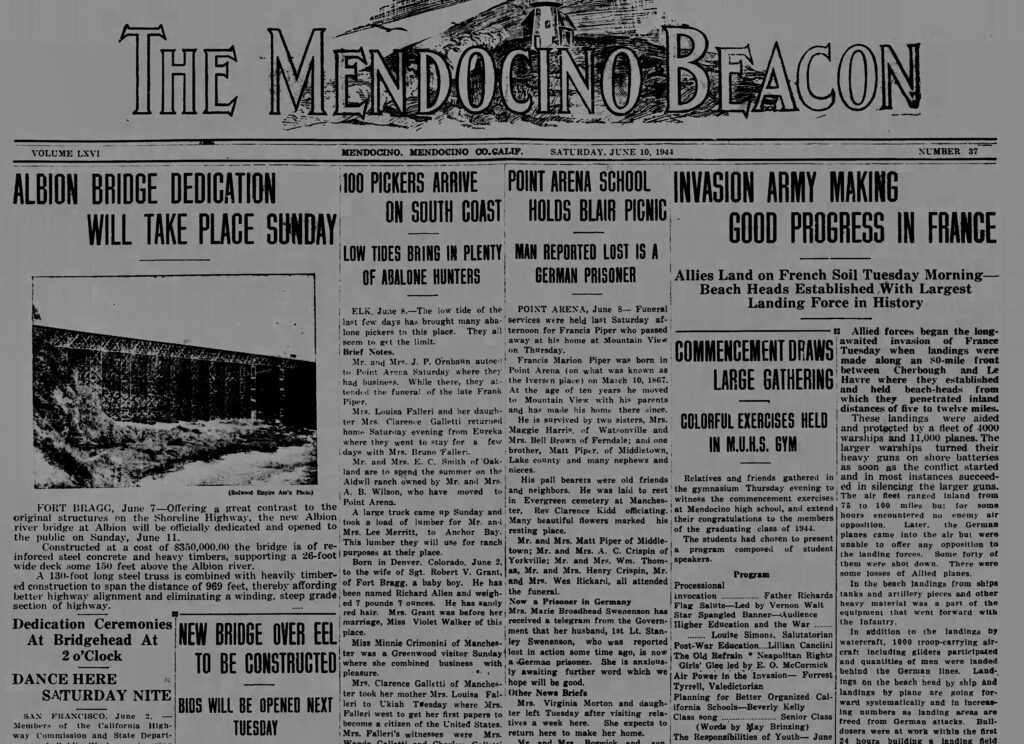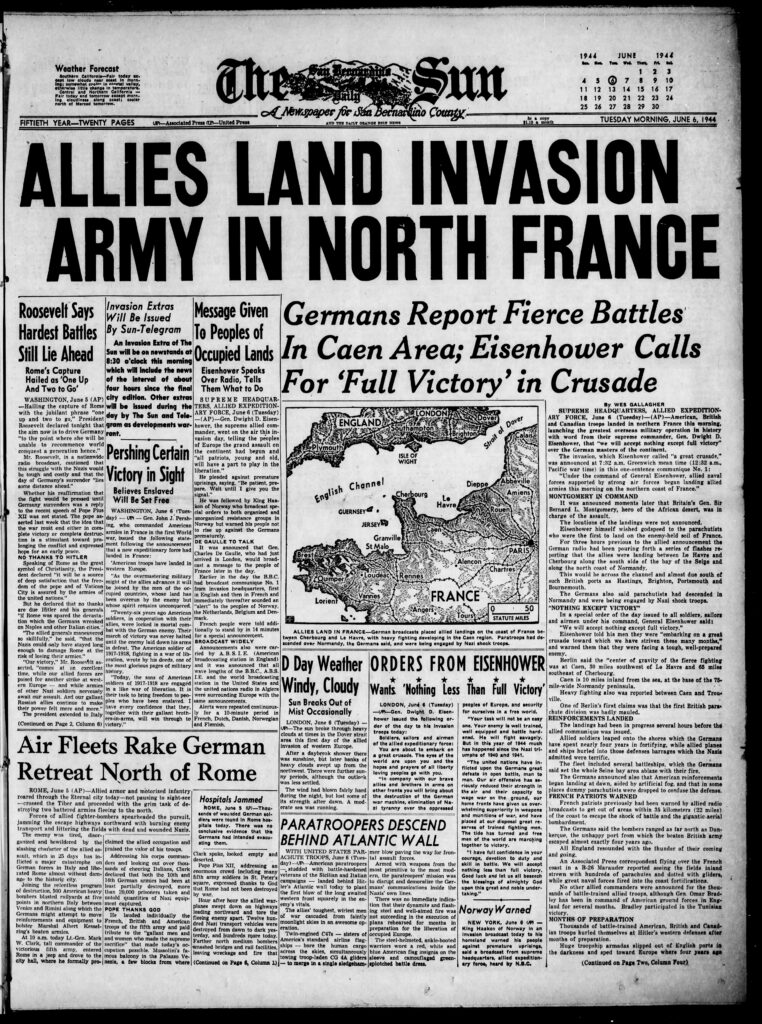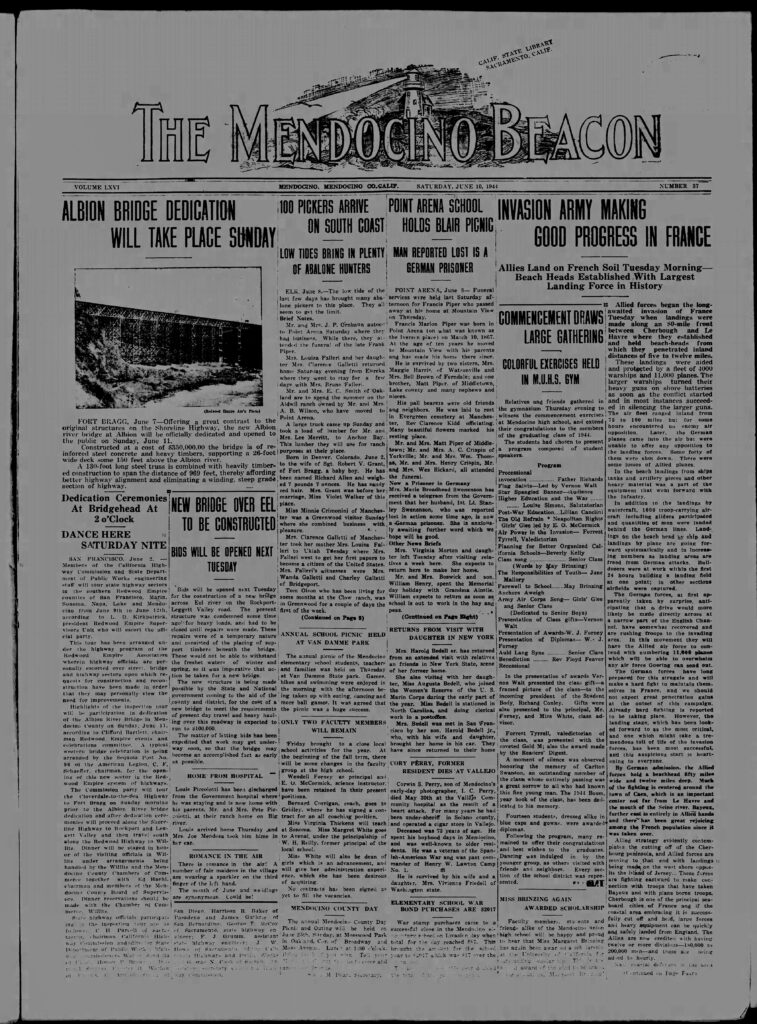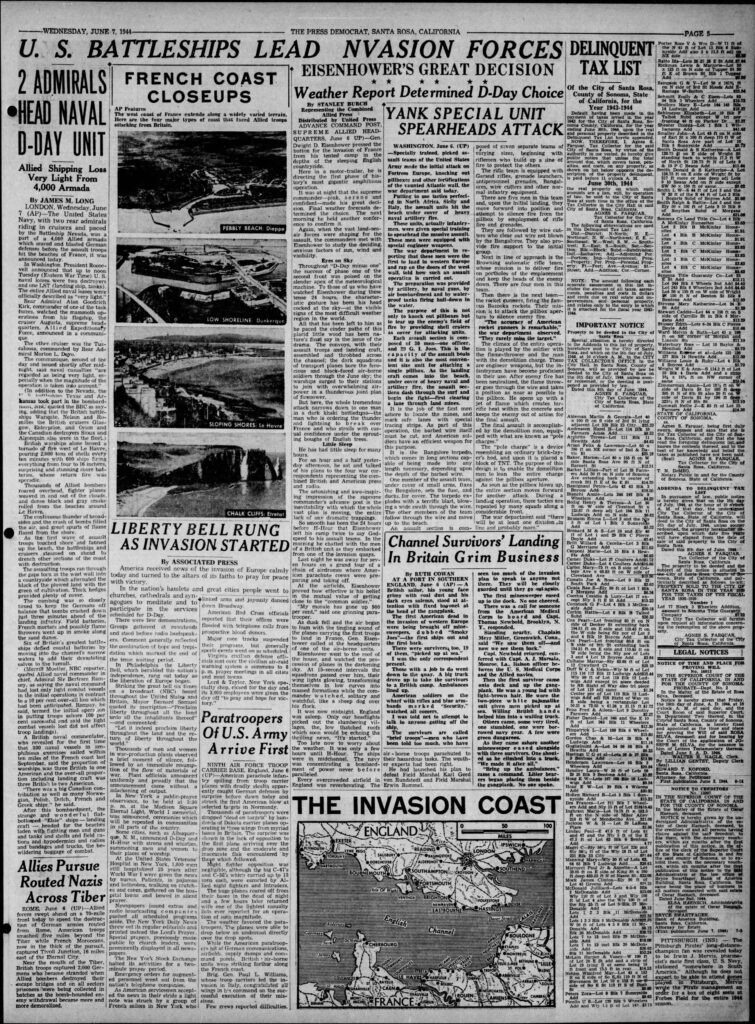Abalone limits, Albion Bridge, engagements share D-Day headlines in Mendocino Beacon of 1944
Check out the local headlines in the Beacon from the issue after D-Day and two other of my old newspapers.
The Mendocino Beacon did its usual reporting on three women getting engaged, a big shakeup at Mendo High and people having big success rockpicking abalone, up to the limit. The limit was 10 at the time but people had already become alarmed at the decline of abalone. The next year, 1945, the Department of Fish and Game, now DFW, took over regulation and in 1953 only picking and free diving were allowed methods.

The Albion Bridge had just been finished, made of wood because of the war effort forbidding steel. The bridge was delayed for almost a year because the original order demanded redwood, but by 1944, nobody could find redwood that big anymore, so Douglas fir was harvested in Oregon and trucked in. The steel bridge over the eel still stands.
In the WWII news, the Beacon reported on a Mendocino man captured by the Germans and gave a report from the wires.
My pops and Uncle Paul heard about this while serving in the Pacific, I heard that this news was received with total elation. They were waiting for the war over there to be done so they would get full support.
Americans were fighting island by island toward Japan but Roosevelt had agreed with Stalin and Churchill to end the war in Europe first so troops to the West knew they didn’t have the full support yet. The battle for Saipan was underway in the Pacific on Day, which the Americans would soon win.
This was as close as I could get to June 6, 1944 in the Beacon, but you gotta love he old Beacon. The brand new Albion Bridge was big news then, as it is now Nothing too big or too small to report.
Here is more about today from the history channel
On June 6, 1944, Supreme Allied Commander General Dwight D. Eisenhower gives the go-ahead for the largest amphibious military operation in history: Operation Overlord, the Allied invasion of northern France, commonly known as D-Day.
By daybreak, 18,000 British and American parachutists were already on the ground. An additional 13,000 aircraft were mobilized to provide air cover and support for the invasion. At 6:30 a.m., American troops came ashore at Utah and Omaha beaches.
The British and Canadians overcame light opposition to capture Gold, Juno and Sword beaches; so did the Americans at Utah. The task was much tougher at Omaha beach, however, where the U.S. First Division battled high seas, mist, mines, burning vehicles—and German coastal batteries, including an elite infantry division, which spewed heavy fire. Many wounded Americans ultimately drowned in the high tide. British divisions, which landed at Gold, Juno, and Sword beaches, and Canadian troops also met with heavy German fire.
History Shorts: The Night Before D-Day
Under the cover of darkness, the Allies pulled off an operation in the hours before D-Day that may have changed the tide of the battle before it had begun.
But by day’s end, 155,000 Allied troops–Americans, British and Canadians–had successfully stormed Normandy’s beaches and were then able to push inland. Within three months, the northern part of France would be freed and the invasion force would be preparing to enter Germany, where they would meet up with Soviet forces moving in from the east.

Before the Allied assault, Hitler’s armies had been in control of most of mainland Europe and the Allies knew that a successful invasion of the continent was central to winning the war. Hitler knew this too, and was expecting an assault on northwestern Europe in the spring of 1944. He hoped to repel the Allies from the coast with a strong counterattack that would delay future invasion attempts, giving him time to throw the majority of his forces into defeating the Soviet Union in the east. Once that was accomplished, he believed an all-out victory would soon be his.
For their part, the Germans suffered from confusion in the ranks and the absence of celebrated commander Field Marshal Erwin Rommel, who was away on leave. At first, Hitler, believing that the invasion was a feint designed to distract the Germans from a coming attack north of the Seine River, refused to release nearby divisions to join the counterattack and reinforcements had to be called from further afield, causing delays.

He also hesitated in calling for armored divisions to help in the defense. In addition, the Germans were hampered by effective Allied air support, which took out many key bridges and forced the Germans to take long detours, as well as efficient Allied naval support, which helped protect advancing Allied troops.
Though D-Day did not go off exactly as planned, as later claimed by British Field Marshal Bernard Montgomery–for example, the Allies were able to land only fractions of the supplies and vehicles they had intended in France–the invasion was a decided success. By the end of June, the Allies had 850,000 men and 150,000 vehicles in Normandy and were poised to continue their march across Europe.

The heroism and bravery displayed by troops from the Allied countries on D-Day has served as inspiration for several films, most famously The Longest Day (1962) and Saving Private Ryan (1998). It was also depicted in the HBO series Band of Brothers (2001).

